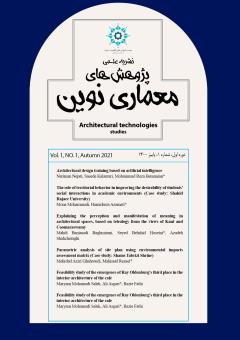Improving the Quality of Urban Public Spaces, with the Emphasis on Murals (Case Study: Qazvin)
Subject Areas :
Abolfazl Toghraii
1
![]() ,
Kia Massoudi
2
,
Erfan Toghraei
3
,
Kia Massoudi
2
,
Erfan Toghraei
3
1 - PhD researcher in Urban Planning, Faculty of Arts, Tarbiat Modares University, Tehran, Iran
2 - Master student in Landscape Architecture, School of Building Environmental Planning, Berlin University of Technology, Berlin, Germany
3 - Master Student of Urban Design, Faculty of Civil Engineering and Architecture, Qazvin Branch, Islamic Azad University, Qazvin, Iran
Keywords: Public Art, Urban Public Space, Street Art, Murals, Qazvin, Public Preference,
Abstract :
Public Arts are one of the cheapest and most accessible alternatives for achieving alive urban places. This kind of art, the name implies, is born, raised, and matured from byways corners of a city and its living streets. In most European countries, the importance of Public Arts has been proved so obviously. In such countries, they consider complete separate Planning Acts from Master Plans for Public Arts, usually called "Public Art Master Plan" with a long-term vision and practical strategies. Furthermore, in numerous countries, Public Art has not been considered just as an aesthetic aspect with official purposes, but also as a means for transmitting the society’s ideologies and attitudes, especially the society’s intellectuals. Murals in this category are one of the most colorable and effective types of Public Arts that can be executed on cities walls in different ways: Official or Graffiti, Professional or Amateur, Long term or Short Term, etc. In this research, we have tried to pay more attention to Public Arts generally and Murals particularly and make a unique collection of valid and updated information on this subject. In the end, we have offered some solutions and local strategies for making Qazvin city public spaces better places to live practically, with the help of Public Arts and Murals. The conclusion is a design framework achieved by public Preferences.
1. اسماعیلپور، ه. (۱۳۹۴). اکباتان و آپادانا پایتختهای گرافیتی ایران. همشهری محله. 25 خرداد 1394.
2. بلیکی، ن. (1398). طراحی پژوهشهای اجتماعی. ترجمه چاوشیان، ح. تهران: نشر نی.
3. پایگاه اطلاعرسانی فرهنگ ایثار و شهادت www. navideshahed. com.
4. تولایی، ن. و پدوند، ش. (1378). آشنایی با ویژگیهای فضایی-مکانی مسجد در ایران. مجموعه مقالات همایش معماری مسجد: گذشته، حال و آینده. جلد دوم. تهران: دانشگاه هنر.
5. حيدرزاده، پ. (1380) .سيري در نقاشي ديواري ايران و جهان. تهران: انتشارات دانشكده هنر و معماري.
6. حسامي، م. (1388) .نقاشي ديواري از طرح تا مرمت. تهران: انتشارات سمت.
7. خونساری، ش. (1395). نقش عکس در بازنمایی اسطوره شهادت در نقاشی دیواری شهر تهران. منظر، 8(36)، 12-19.
8. رستمی، م.، سروری زرگر، ر. و عینی، ح. (1396). تبیین و ارزیابی مؤلفههای هنر عمومی (نمونه موردی: پارک لامپینی بانکوک و ایلگلی تبریز). باغ نظر ،(49). 53-64.
9. رنجبر، ا. (1395). مقدمهای بر هنر شهری و سیاستهای ارتقا آن در کلان¬شهر تهران. دانش شهر(349)، تهران: مرکز مطالعات و برنامه¬ریزی شهر تهران.
10. زنگی، ب. (1395). کاربست دیوارنگاری شهری در دستیابی به منظر شهری انسان¬گرا. منظر (35). 40-49.
11. زنگی، ب. و احمدی، ب. (1395). بررسی کارکردهای هویتبخش هنر شهری دیوارنگاری در شهر ایرانی اسلامی. هنرهای صناعی اسلامی. ۱ (۱) :۴۶-۳۹.
12. کفشچیان مقدم، ا. (1383). بررسی ویژگیهای نقاشی دیواری. هنرهای زیبا (20). 67-78.
13. کفشچیان مقدم، ا. (1388). بررسی دیوارنگاری معاصر تهران. قبل و بعد انقلاب. هنرهای زیبا (33). 103-114.
14. کفشچیان مقدم، ا.، دارش، ی. و رویان، س. (1390). ارزیابی دیوارنگاری معاصر تهران از دیدگاه مخاطب. هنرهای زیبا- هنرهای تجسمی. 2 (41). 63-70.
15. کشیر، م. و کفشچیان مقدم، ا. (1399). بررسی تاثیر کیفیتهای بصری محیط بر نقاشی دیواری. پیکره (19). 42-55.
16. كوثري، م. (1388). درآمدي بر موسيقي عامه پسند. تهران: نشر طرح آينده.
17. لنگ، ج. (1395). آفرینش نظریه معماری. ترجمه عینیفر، ع. تهران: دانشگاه تهران.
18. مظفریخواه، ز. و کفشچیانمقدم، ا. (1391). قابلیتهای هنر کمینه (مینیمال) در گرافیک محیطی شهری با تأکید بر نمونههای دیوارنگارههای شهری ایران. فصلنامه نگره، 7(22), 85-102.
19. Borgia, Nina & Grede, Stephan. (2009). Public Art Masterplan. London
20. City of Burlington. (2018). Public Art Master Plan Update. Burlington
21. Croydon Council. (2006). Public Art Master Plan for City of Croydon. Croydon.
22. Granger, F. (1934) “Virtuvius on Architecture” 2 Vol, New York; G. P. Putnam’s Sons.
23. Hornby, A. (2006). Oxford Advanced Learner’d Dictionary, Oxford: Oxford U. P.
24. Kwon, M. (2002). One Place After Another: Site Specificity and Locational Identity, MIT Press.
25. Mitrache’, G. (2012). Architecture-art-public space. Procedia social and Behavioral sciences 51. 560-571.
26. Motoyama, Y. & Hanyu, k. (2014). Does public art enrich landscape? The effect of public art on visual properties and effective appraisals of landscapes. Journal of Environment. 12-20.
27. Remser, A. (2005). Urban Regeneration on Challenge for Public Art, University of Barcelona: Departmen of Psychology-social.
28. Reshad, Karan. (2006). Urban Art. Kolah Studio, published online.
29. Transport & Regional Affairs Department.of the Environment. (2000). By Design: Urban Design in the Planning System: Towards Better Practice. London: Thomas Telford.
30. Vale of Glamorgan Council. (2018) Public Art in New development SPG. Vale of Glamorgan.


